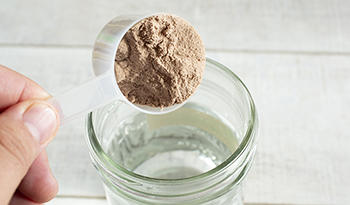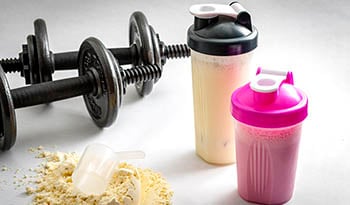Kazeina a białko serwatkowe: Kiedy używać każdego z nich, aby wspierać wydajność

Dwa z najpopularniejszych suplementów dla osób aktywnych i prowadzących zdrowy tryb życia to kazeina i białko serwatkowe w proszku. W rzeczywistości, jeśli regularnie ćwiczysz, trudno będzie ci znaleźć kogoś wokół siebie, kto nie spożywa jakiejś formy koktajlu proteinowego od czasu do czasu, niezależnie od tego, czy jest to regularne, czy nie.
Białko jest niezbędne dla osób aktywnych, ponieważ odgrywa główną rolę w regeneracji i tworzeniu nowych mięśni. Kiedy ćwiczymy, obciążamy mięśnie, co powoduje większe zapotrzebowanie na białko, aby prawidłowo się odbić i wrócić silniejszym. Białko jest również niezbędne do utrzymania masy ciała i składu ciała.
Koktajle serwatkowe i kazeinowe są świetnymi suplementami, ponieważ można je łatwo dodać do każdej diety i pomagają zwiększyć dzienne spożycie białka - są zasadniczo niezawodnym sposobem na zapewnienie wystarczającej ilości białka.
W tym artykule omówimy, czym są białka serwatkowe i kazeinowe, główne różnice między nimi, kiedy należy spożywać każde z nich, jak je stosować i wiele więcej!
Czym są białka serwatkowe i kazeinowe?
Zanim zagłębimy się w różnice między serwatką a kazeiną, warto najpierw zrozumieć, czym jest każde białko. Każdy rodzaj białka będzie miał swoje własne odmiany, a zrozumienie tych subtelnych różnic może pomóc w podjęciu lepszej decyzji o tym, które z nich spożywać.
Białko serwatkowe
Koktajle z białka serwatkowego to produkty na bazie nabiału, które pochodzą z płynnych produktów ubocznych produkcji sera. Koktajle białkowe z serwatki są szybko trawione przez organizm, dzięki czemu doskonale nadają się do wspomagania syntezy białek mięśniowych w odpowiednim czasie.
Istnieje wiele wariantów tradycyjnego shake'a białka serwatkowego. Różne rodzaje białka serwatkowego wpływają na strawność i mieszalność. Trzy najpopularniejsze rodzaje białka serwatkowego obejmują:
- Koncentrat serwatki: Nieco przetworzony i zawiera niewielką ilość tłuszczu i węglowodanów
- Izolat białka serwatkowego: Przetworzona serwatka, z której usunięto laktozę i tłuszcz
- Hydrolizat białka serwatkowego: Wysoce przetworzona serwatka, która przechodzi proces, który zasadniczo czyni ją "wstępnie strawioną" (oczywiście nie dosłownie) w celu zwiększenia biodostępności
Ważne jest, aby zrozumieć różnice między rodzajami białka serwatkowego, ponieważ wyższa jakość serwatki - izolat lub hydrolizat - generalnie skutkuje lepszą biodostępnością, mniejszym dyskomfortem trawiennym z powodu mniejszej ilości laktozy i lepiej miesza się z każdym rodzajem płynu.
Białko kazeinowe
Białko kazeinowe, podobnie jak serwatka, jest produktem ubocznym pochodzącym z produkcji sera. Białko to wyściela wnętrze żołądka po spożyciu i jest trawione znacznie wolniej, co sprawia, że doskonale nadaje się do długotrwałego uwalniania białka.
Podobnie jak białko serwatkowe, białko kazeinowe również ma kilka głównych wariantów, które warto znać. Różne białka kazeinowe różnią się w zależności od stopnia przetworzenia każdego z nich, co sugeruje różnice w trawieniu. Warto znać dwa główne rodzaje kazeiny:
- Kazeina micelarna: Najpopularniejszy, nienaruszony rodzaj kazeiny w proszku na rynku.
- Hydrolizowana kazeina: Przetworzona kazeina, która ma być nieco łatwiejsza do strawienia
Zauważalną różnicą między wariantami białka serwatkowego i kazeinowego jest to, że różne rodzaje kazeiny w proszku są nadal dość słabo zbadane. Ponieważ kazeina jest wolno trawionym źródłem białka, można argumentować, że hydrolizowana, droższa przetworzona kazeina nie jest warta swojej ceny, ponieważ badania są wciąż zbyt rzadkie, aby sugerować jakiekolwiek ostateczne twierdzenia.
Co jest lepsze? Serwatka vs. Białko kazeinowe
Na poziomie lokalnym koktajle białkowe serwatkowe i kazeinowe są podobne, ponieważ oba są oparte na nabiale i zawierają wystarczającą ilość białka na porcję. Dodatkowo, białko serwatkowe i kazeinowe w proszku są kompletnymi źródłami białka, co oznacza, że zawierają wszystkie dziewięć niezbędnych aminokwasów . (elementy budulcowe białka).
Poza tymi dwoma głównymi podobieństwami, produkty te zawierają wiele różnic, które warto znać dla każdego, kto debatuje nad ich konsumpcją. Rozumiejąc różnice między nimi, możemy podejmować najbardziej świadome decyzje dotyczące tego, kiedy produkty te powinny być skutecznie stosowane w codziennej diecie.
W końcu, ponieważ są to suplementy, ich stosowanie powinno być uzupełnieniem diety w sposób, który zarówno ma sens, jak i wspiera wydajność.
Szybkość trawienia
Główną i najbardziej zauważalną różnicą między białkiem serwatkowym i kazeinowym w proszku jest szybkość trawienia każdego z nich. Zrozumienie tej różnicy ma fundamentalne znaczenie, ponieważ może pomóc w określeniu, kiedy skutecznie spożywać każdy z nich w celu wzrostu i regeneracji.
Białko serwatkowe jest szybko trawione przez organizm, dzięki czemu doskonale wspomaga syntezę białek mięśniowych. Dlatego też wiele osób sugeruje spożywanie koktajlu z białka serwatkowego po treningu lub po przebudzeniu rano - są to dwa momenty, w których napływ białka może być najłatwiej wykorzystany przez organizm.
Myśląc o szybkości trawienia białka serwatkowego i o tym, który wariant jest najszybszy, najłatwiej jest myśleć o trzech typach na spektrum szybkości. Im bardziej przetworzone jest białko serwatkowe, tym szybciej będzie trawione, ponieważ będzie wymagało od organizmu mniej energii na rozkład i wykorzystanie białka.
Koncentrat serwatki byłby najwolniejszy do strawienia, a hydrolizat białka serwatki byłby najszybszy, pozostawiając . Izolat białka serwatkowego gdzieś pomiędzy.
Różnice między każdym z powyższych rodzajów białka są stosunkowo niewielkie, ale niewielka przewaga jest często wystarczająca, aby wiele osób wzięło pod uwagę różnice w szybkości trawienia w celu szybkiego wykorzystania białka przy wyborze produktu.
W przeciwieństwie do szybkiego trawienia białka serwatkowego, kazeina jest znacznie wolniejszym białkiem. Kiedy kazeina jest spożywana, tworzy w żołądku gęstą, żelową substancję, która następnie przedłuża jej trawienie i rozkład, tworząc długotrwałe uwalnianie białka.
Zmienia to najlepsze zastosowania kazeiny w porównaniu z serwatką, ponieważ wolniej trawione białko nie jest oczywiście idealne w warunkach, w których organizm potrzebuje białka.
Najlepszy czas na spożywanie białka
Ponieważ serwatka i kazeina różnią się tak bardzo pod względem szybkości trawienia, każda z nich będzie się różnić pod względem tego, kiedy powinny być spożywane. W rzeczywistości oba suplementy można spożywać o dowolnej porze dnia, ale ponownie mówimy o najskuteczniejszych sposobach spożywania każdego z nich.
Najlepszy czas na spożycie białka serwatkowego:
- Przed lub po ćwiczeniach
- Jako przekąska w południe, aby zwiększyć zawartość białka w przekąsce
- Przy śniadaniu, jeśli żywność bogata w białko nie jest dostępna
Najlepszy czas na spożycie białka kazeinowego:
- Przed snem
- Jako przekąska, aby powstrzymać głód i promować sytość
Ogólnie rzecz biorąc, kazeina będzie spożywana głównie przed snem, ponieważ długotrwałe uwalnianie białka może pomóc w regeneracji w nocy podczas snu.
Najlepsze sposoby spożywania każdego z nich
Zarówno białko serwatkowe, jak i kazeinowe można mieszać z wodą lub mlekiem i pić jako koktajle, jednak ze względu na znaczne różnice w ich grubości nie zawsze jest to przyjemne doświadczenie.
Białko serwatkowe będzie generalnie lepiej mieszać się z płynem, co ułatwi jego spożywanie i picie bez zbrylania się lub zbytniej gęstości. Oprócz mieszania w formie koktajlu z ulubionym płynem, białko serwatkowe można również dodawać do takich rzeczy jak płatki owsiane , aby zwiększyć zawartość białka w normalnie bogatym w węglowodany pożywieniu.
Białko kazeinowe będzie znacznie gęstsze po zmieszaniu z płynem, co może sprawić, że picie go będzie bardzo nieprzyjemne - wyobraź sobie picie lekko rozwodnionych lodów. Biorąc to pod uwagę, kazeina jest świetna do spożycia jak pudding. Zamiast mieszać kazeinę w koktajlu, wymieszaj ją w misce i dodaj wodę lub mleko, a następnie można ją spożywać jak budyń. Kazeinę można również dodawać do żywności, takiej jak płatki owsiane i lody.
Odżywianie
Ogólnie rzecz biorąc, nie będzie dużej różnicy w zawartości kalorii i makroskładników odżywczych między koktajlami serwatkowymi i kazeinowymi . Niewielkie różnice sprowadzają się do rodzaju spożywanej serwatki i kazeiny. Bardziej przetworzone produkty zawierają mniej tłuszczu i węglowodanów, co zwykle zmniejsza całkowitą zawartość kalorii.
Aby dać wyobrażenie o tym, co zawierają normalne porcje, wymieniliśmy typowe spektrum kalorii i makroskładników odżywczych dla białek serwatkowych i kazeinowych.
Uwaga: Poniższe informacje mogą się różnić w zależności od produktu. Są to ogólne liczby, których można oczekiwać w białkach serwatkowych i kazeinowych w proszku.
Izolat białka serwatkowego:
- Kalorie: 120
- Tłuszcz: 0g
- Węglowodany: <1g
- Białko: 30g
Białko kazeinowe:
- Kalorie: 120
- Tłuszcz: 1g
- Węglowodany: 3g
- Białko: 24 g
Jak widać, nie ma dużej różnicy między kalorycznością i makroskładnikami odżywczymi między produktami, dlatego ważne jest, aby zrozumieć ich różnice w szybkości trawienia i zastosowaniach.
Wybierając białko serwatkowe lub kazeinowe do uzupełnienia codziennej diety, należy wziąć pod uwagę kalorie i rozkład makroskładników każdego produktu, aby upewnić się, że odpowiada on codziennemu zapotrzebowaniu. Na przykład opcja wysokokaloryczna nie byłaby idealna dla osób, które próbują schudnąć, mając do dyspozycji ograniczoną ilość kalorii.
Uwaga: Zawsze dobrym pomysłem jest skonsultowanie się z odpowiednim lekarzem przed wprowadzeniem do diety jakiegokolwiek nowego suplementu. W przypadku osób spożywających te produkty po raz pierwszy, dobrym pomysłem jest również skonsultowanie się z dietetykiem, aby pomóc w ustaleniu najlepszych praktyk konsumpcyjnych.
Przemyślenia końcowe
Białka serwatkowe i kazeinowe w proszku mają ze sobą wiele wspólnego, jeśli chodzi o ich skład, ale różnią się dość znacznie, jeśli chodzi o najlepsze praktyki ich stosowania. Rozumiejąc różnice między nimi, osoby aktywne mogą stworzyć plan gry dla każdego białka, który najlepiej pokrywa się z ich celami.
Referencje:
WYŁĄCZENIE ODPOWIEDZIALNOŚCI:Celem niniejszej Strefy Zdrowia nie jest stawianie diagnoz...














































































 Spis treści
Spis treści















